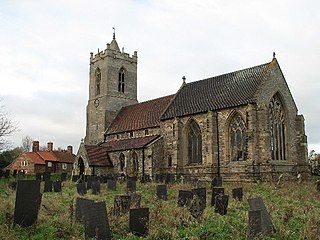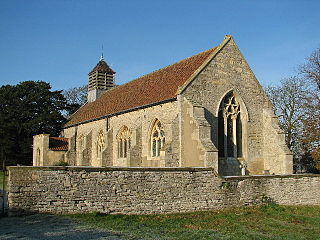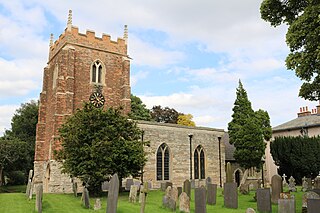
East Bridgford is a village and civil parish in the Rushcliffe borough of Nottinghamshire, east of the city of Nottingham. It had a population of 1,814 at the 2011 census, falling to 1,763 at the 2021 census. The village adjoins the south bank of the River Trent, opposite the village of Gunthorpe. It is on the Trent Valley Way. East Bridgford's annual village show is run by the village Horticultural Society, established in 1864, and held every Feast Week.

Car Colston is an English village and civil parish in the Rushcliffe borough of Nottinghamshire. The population of the civil parish at the time of the 2011 census was 185, falling to 171 at the 2021 census.

Kingston on Soar is a village and civil parish in the Rushcliffe borough of Nottinghamshire, England.

Epperstone is an English village and civil parish in mid-Nottinghamshire, located near Lowdham and Calverton. It had a population of 589 at the time of the 2011 census, falling to 517 at the 2021 census. Many inhabitants commute to work or school in Nottingham 9 miles (16 km) to the south-west.

Thurgarton is a small village in rural Nottinghamshire, England. The village is close to Southwell, and Newark-on-Trent and still within commuting distance to Nottingham. It is served by Thurgarton railway station. According to the 2001 census it had a population of 412, increasing to 440 at the 2011 census and marginally to 445 at the 2021 census.

Flintham is a village and civil parish in the Rushcliffe district in Nottinghamshire, 7 miles from Newark-on-Trent and opposite RAF Syerston on the A46. It had a population of 597 at the 2011 census, estimated at 586 in 2019, and a fall to 563 at the 2021 census. The village name was taken by the Ham class minesweeper HMS Flintham.

Upton is a small village in Nottinghamshire, England, 2 miles (3.2 km) east of Southwell, 5 miles (8.0 km) west of Newark and 3 miles (4.8 km) south of Hockerton; it lies on the A612 Nottingham-Newark road. In 1889, the village was described as sitting on a bend in the main road, "on the summit of a hill which commands a fine view of the Trent Valley.... The church, which is a prominent feature in the landscape, has a substantial Perpendicular tower crowned by eight pinnacles, and having in the centre a lofty master pinnacle which rises above its neighbours, and so adds materially to the effect."

Hawton is a hamlet and civil parish in the Newark and Sherwood district of Nottinghamshire, England. It lies two miles (3.2 km) south of the town of Newark-on-Trent, near the River Devon, a tributary of the River Trent. Its population was recorded as 147 in the 2011 census. Hawton alone reported 80 residents at the 2021 census.

Hoveringham is a small village and civil parish in Nottinghamshire, about 10 miles (16 km) northeast of the county town of Nottingham and on the west side of the River Trent, and just off the A612 trunk road to Southwell. The population of the civil parish as taken at the 2011 census was 359, decreasing to 308 at the 2021 census. The adjacent area has extensive sand and gravel deposits which have been quarried there for many years.

Thorpe is a hamlet in the Newark and Sherwood district of Nottinghamshire, England. It lies to the east of East Stoke and 1 mile from the A46 Fosse Way. It i situated in the countryside southwest of Newark. The population was 69 at the 2021 census.

Gonalston is a small village in Nottinghamshire lying just to the north-east of Lowdham and almost upon the A612 trunk road that runs from Nottingham to Southwell. Gonalston comprises 1,096 acres of arable and pasture land in about equal portions, interspersed with 106 acres (0.43 km2) of wood and plantations. It lies on a small river called the Dover Beck which separates the village from Lowdham and which flows south-east into the River Trent 2 miles (3.2 km) away. Population for the 2021 census was 83 residents.

Rolleston is a small village and civil parish in Nottinghamshire by the River Greet, a few miles from Southwell not far from the Trent and about 5 miles (8.0 km) southwest of Newark. The population of the civil parish at the 2011 census was 312, increasing to 342 at the 2021 census. It has a church dedicated to the Holy Trinity. It lies close to the railway line between Nottingham and Lincoln with a station serving the village and Southwell as well as the nearby Southwell Racecourse.

Cotham, Nottinghamshire is a hamlet and civil parish near Newark-on-Trent in the East Midlands of England.

Teversal is a village in the Ashfield district of Nottinghamshire, England. It lies north of Sutton-in-Ashfield and 3 miles (5 km) west of Mansfield. It is close to the boundary with Derbyshire. Former names include Tevershalt, Teversholt, Tyversholtee, Teversale, Tevershall and Teversall.

Thoroton is a small English village and civil parish in the borough of Rushcliffe, and the county of Nottinghamshire, with a population of 112 at the 2011 census, and increasing to 130 at the 2021 census. The village has conservation area status. Its Anglican parish church is a Grade I listed building.

Hawksworth is an English conservation village and civil parish in the Rushcliffe borough of Nottinghamshire. It lies 10 miles (16 km) south of Newark-on-Trent, adjacent to the villages of Flintham, Sibthorpe, Thoroton, Scarrington and Screveton.

Screveton is an English civil parish and village in the Rushcliffe borough of Nottinghamshire, with 191 inhabitants at the 2011 census. Screveton singularly reported 164 residents at the 2021 census. It was formerly in Bingham Rural District and before 1894 in Bingham Wapentake. It is adjacent to Kneeton, Flintham, Hawksworth, Scarrington, Little Green and Car Colston.

North Clifton is a village and civil parish about 12 miles north of Newark-on-Trent, in the Newark and Sherwood district, within the county of Nottinghamshire, England. In 2011, the parish had a population of 216, and this dropped to 176 at the 2021 census. The parish touches Thorney, Fledborough, Newton on Trent, South Clifton and Ragnall.

Marnham is a civil parish in the Bassetlaw district, in the county of Nottinghamshire, England. The parish includes the village of Low Marnham and the hamlets of High Marnham and Skegby. In the census of 2021 the parish had a population of 136. The parish lies in the north east of the county, and south east within the district. It is 122 miles north of London, 23 miles north east of the city of Nottingham, and 17 miles north east of the market town of Mansfield. The parish touches Fledborough, Normanton on Trent, South Clifton, Tuxford and Weston. Marnham shares a parish council with Normanton on Trent. There are 7 listed buildings in Marnham.

Skegby is a hamlet within the Marnham civil parish in Bassetlaw district, of the county of Nottinghamshire, England. It lies in the north east of the county, south east within the district and centre south of the parish. It is 122 miles (196 km) north of London, 23 miles (37 km) north east of the city of Nottingham, and 17 miles (27 km) north east of the market town of Mansfield. There are two listed buildings in the area.






















